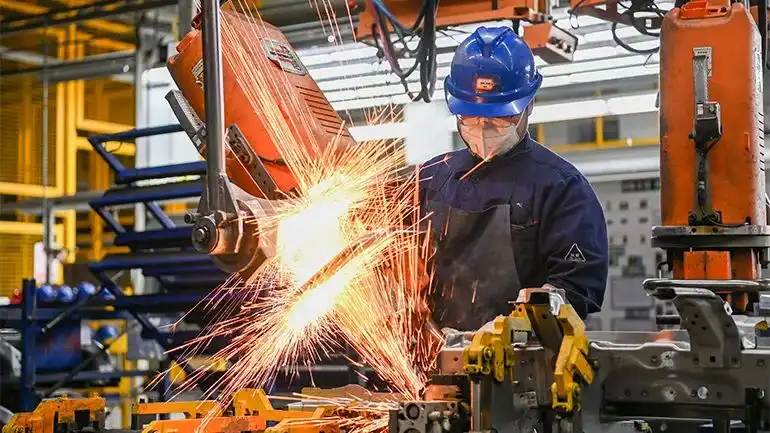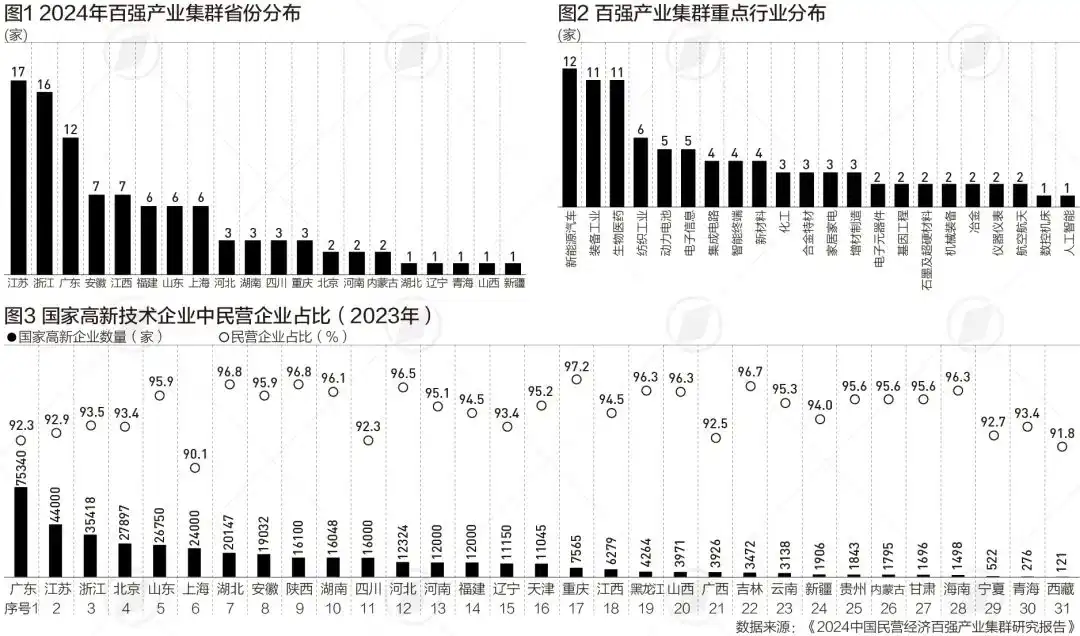Jiangsu, Zhejiang and Guangdong take the lead, and private enterprises take responsibility in the top 100 industrial clusters
2024.0328

Number of words in this article:2312, reading time is about 4 minutes
introduction: 百强集群涉及20个省份,江苏、浙江、 广东等民营经济活跃地区表现抢眼,分别入围17个、16 个、12个,合计占比45%。
** Author| ** First Financial Gold Leaf
In recent years, support policies to encourage industrial agglomeration and development have been intensively introduced from the central government to local governments, forming a number of manufacturing and strategic emerging industrial clusters with national influence. Industrial clusters dominated by strategic emerging industries have become important engines leading regional economic development. The country is forming multiple systems including trillion-level clusters, strategic emerging industry clusters, future industrial clusters, as well as world-level clusters, national-level clusters, and regional-level clusters.
Recently, the China Private Economy Research Association and the Shangdian Branch jointly released the "2024 Research Report on China's Top 100 Private Economy Industrial Clusters"(hereinafter referred to as the "Report"). The report shows that the top 100 clusters have gathered 1.801 million private enterprises, contributing nearly 50,000 national high-tech enterprises, 3000 national specialized and innovative "little giant" enterprises, and 1800 listed companies. In 2024, the total financing amount of private enterprises in the top 100 clusters will exceed 400 billion yuan, accounting for nearly 50%.
"The report focuses on more than 2000 private economic industrial clusters across the country, focusing on the development characteristics, regional distribution, cluster types and development trends of private economic industrial clusters, so as to highlight the private economy's role in driving the germination, development and growth of industrial clusters. The key role played in the process." Sun Huifeng, director of the China Private Economic Research Association and chairman of Beijing Shangqi Digital Technology Co., Ltd., introduced First Finance and Economics.
Guangdong ranks first in the number of private enterprises
As of the end of 2023, the number of registered private enterprises nationwide exceeded 59 million, a year-on-year increase of 16.1%, accounting for 92.7%.
Private enterprises are the main force in new productivity, 90% of the specialized and innovative "little giants" and 94% of the national high-tech enterprises are private enterprises.
According to the report, there are more than 30 million private enterprises in the eastern region, accounting for 53.6%; the central region accounts for 21.72%, and the western region accounts for 19.8%. In central and western provinces such as Hubei, Hunan, and Shaanxi, the number of private enterprises has increased by more than 10%. Guangdong ranks first in the number of private enterprises, with more than 7.2 million; Shandong Province has more than 5 million; Jiangsu and Zhejiang rank third and fourth, both with more than 3 million.
Private enterprises are the main force in scientific and technological innovation. As of December 2023, there are more than 460,000 national-level high-tech enterprises, with private enterprises accounting for 94%; there are 103,000 specialized and innovative enterprises nationwide, with private enterprises accounting for 95%; Technological innovation results Private enterprises contribute about 70%.
Quanzhou's private economy accounts for the highest proportion (97%) among the 24 trillion-dollar GDP cities in the country, contributing 72% of tax revenue, 83% of GDP, 90% of technological innovation results, and 92% of employment.
Since last year, a series of measures to promote the development and growth of the private economy have been implemented and effective. Data from the National Bureau of Statistics show that from January to February, among industrial enterprises above designated size, the profits of state-controlled enterprises increased by 0.5% year-on-year, and the profits of private enterprises increased by 12.7%; the profits of large, medium and small enterprises increased by 8.0%, 6.0%, and 18.9% respectively.

Jiangsu, Zhejiang and Guangdong lead the cluster
The report shows that 70% of the top 100 industrial clusters are concentrated in the east. There are 68 industrial clusters in the eastern region, with Jiangsu, Zhejiang and Guangdong provinces gathering nearly 50% of the industrial clusters. There are 13 cities with more than 3 (inclusive) industrial clusters, including Shanghai, Suzhou, Changzhou, Foshan, Guangzhou, Hangzhou, Hefei, Ningbo, Shenzhen, Taizhou, Wuxi, Zhengzhou, and Chongqing; Shanghai and Suzhou have 5 industrial clusters. The number of cities is tied for first place.
First Financial compiled data and found that Jiangsu, which ranks first in the province, has 18 industrial clusters distributed in 8 cities, including 5 in Suzhou, 3 in Wuxi, 3 in Changzhou, 2 in Nanjing, 2 in Lianyungang, and 1 in Xuzhou., 1 in Nantong and 1 in Yangzhou.
Zhejiang has the second largest number of industrial clusters, distributed in 7 cities, Ningbo has 3, Taizhou, Shaoxing, Jiaxing, Huzhou and Hangzhou have 2 each, and Wenzhou has 1.
Guangdong has a total of 12 industrial clusters on the list, ranking third among all provinces. Among them, there are 4 in Shenzhen; 2 in Guangzhou, Dongguan and Huizhou; and 1 in Foshan and Zhongshan. It mainly involves manufacturing clusters with advantages in Guangdong, such as new generation information and communication, new energy vehicles, pan-home furnishings, high-end medical equipment, and smart home appliances. The industrial clusters selected by Guangdong are generally ranked high.
There are 21 in the central region, mainly distributed in Anhui, Jiangxi and Hunan; 10 in the western region, with Chongqing and Sichuan having outstanding advantages.
The report shows that the top 100 clusters involve 20 provinces, and Jiangsu, Zhejiang, Guangdong and other areas with active private economy performed well, with 17, 16, and 12 shortlisted respectively, accounting for 45% in total; Five provinces and cities including Anhui, Jiangxi, Fujian, Shandong, and Shanghai have 5 to 8 industrial clusters, mainly composed of first-tier cities and areas with active private enterprises. Among them, Fujian has 6 industrial clusters in the top 100, and the distributed cities are Quanzhou (3), Fuzhou (1), Xiamen (1), and Ningde (1).

From the perspective of industrial structure, high-end manufacturing, mainly high-end equipment, new energy vehicles, integrated circuits, biomedicine, and power batteries, accounts for 70%; industrial clusters with unique local characteristics perform well, such as Hefei's new display industry cluster, Changsha Construction Machinery Industry Cluster, etc.
In terms of industrial chain coverage, the top 100 clusters reach more than 88%, and the industrial chain coverage of key industries such as biomedicine, power batteries, new energy, and textiles and clothing exceeds 92%. In terms of innovation characteristics, 90% of industrial clusters have participated in the construction of national (national) key laboratories and national engineering research centers; a total of 487,000 patents have been authorized, and five major industrial clusters, including new energy vehicles, equipment industry, integrated circuits, new displays, and biomedicine, account for nearly 50%, ranking among the forefront of industrial clusters.
From the perspective of equity financing, the average financing amount of the cluster exceeds 10 billion yuan, and private enterprises in new energy vehicles, biomedicine, robots, integrated circuits, smart sensors and other fields are active in financing. Shanghai Robot Industry Cluster, Shanghai New Energy Vehicle and Key Parts Industry Cluster, Shenzhen High-end Medical Device Industry Cluster, Shanghai Integrated Circuit Industry Cluster, Suzhou Electronic Information Industry Cluster, Shenzhen New Energy Vehicle Industry Cluster, Beijing Artificial Intelligence Industry Cluster, Shenzhen New Generation Information and Communication Industry Cluster, Suzhou Biomedicine and High-end Medical Device Industry Cluster, and Changzhou New Energy Industry Cluster rank in the top ten.
For the next development of the top 100 industrial clusters, the report puts forward five suggestions, including implementing a cluster energy level jump plan, cultivating global supply chain integration capabilities, creating an open collaborative innovation ecosystem, building a digital platform for industrial governance, and adhering to integrated green differentiation.
"For example, to promote the production of products in different regions around the world, future clusters must have the ability to systematically integrate global supply chains. Accelerate the establishment of a modern service industry that matches high-end manufacturing, and enhance the system integration capabilities of leading enterprises to integrate global high-end factors through the creation of super industrial clusters." Sun Huifeng told reporters.
**
